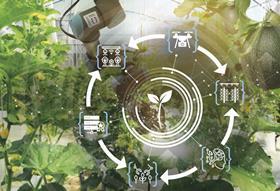
Smart Horticulture Asia (SHA) will take place for the fifth consecutive year at Asia Fruit Logistica ON. This time, it will not be held in a theatre or on the exhibition floor, but rather online.
Just as in years before, the programme will examine the significance of new technology for the cultivation of fruit and vegetables, and the associated supply chain.
We have been noticing far-reaching development in horticulture, which I would describe as ‘unmanned growing’.
One of the consequences of the Covid-19 pandemic is an increasing focus on robotics. Vertical farming has also been booming in the big cities. A number of technological developments are coming together, which are collectively responsible for some drastic changes in the horticulture industry.
‘Unmanned growing’ is the combination of a number of technological developments leading to a form of horticultural production that requires less and less human labour and interaction. According to Schmeitz, it is a combination of the following technologies:
Vertical farming: the development of vertical farming has helped the industry gain more control over the cultivation environment, in which external influences are reduced to the greatest extent possible. The industry has also gained a much more basic knowledge of individual plant control. Incidentally, ‘controlled environment farming’ is a better term. After all, the basic principle of vertical farming is that it takes place in a fully controlled greenhouse.
Autonomous growing: based on various developments in ‘controlled environment farming’, steps have been taken towards the realisation of a system in which cultivation is managed autonomously by a computer through the use of sensors, cameras, data and algorithms.
Robotics: labour is becoming an issue in more and more high-tech horticultural countries. The availability and housing of migrant workers and rising costs are making the use of robots for both harvesting and crop handling, grading and packaging a necessary step.
A number of key enabling technologies play an important role in this respect:
Sensoring and Vision: there are more and more possibilities these days for the collection of information (data/characteristics/KPIs) in relation to the cultivation environment, the crop and even the ‘well-being’ of individual plants.
Data interoperability: standardisation and technology developments such as blockchain make it increasingly easy to store and connect this data.
Artificial Intelligence: the power of our modern-day computers is unprecedented. This means that hundreds of options and models can be calculated in milliseconds in order to make the best decision.
These themes are therefore central to the programme of Smart Horticulture Asia.
Sessions run from 13:00-15:00 Singapore/China time each day at Asia Fruit Logistica ON (18-20 November).



